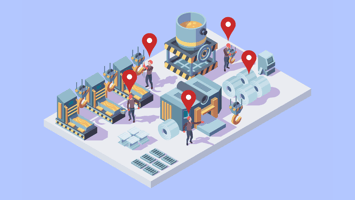Image generated by AI.
The Future of Deskless Workers: New Possibilities Brought About by Business Efficiency
Introduction
In 1999, a revolution started with Salesforce and its Customer Relationship Management (CRM). Software As A Service, or SaaS, was invented, and this model gave birth to many tools that improve how we work. This movement is now even accelerated with frequent breakthroughs in artificial intelligence. However, SaaS solutions mainly targeted office workers, leaving a significant portion of the global workforce underserved. These deskless workers perform their duties outside the traditional office environment, often in challenging conditions and with limited access to the digital tools that have transformed office-based work.
In the past, such problems may have been somewhat accepted. However, labor shortages due to aging and population decline are becoming a severe problem in today's society. If companies and organizations do not respond, they will likely suffer significant losses.
What is a Deskless Worker?
Deskless workers refer to people who are required to work on-site instead of those who can work at an office desk. Their diverse jobs include construction, logistics, manufacturing, healthcare, retail, etc. During the COVID-19 pandemic, while a part of the labour worked remotely from home, deskless workers people continued working on-site.
They make up 80% of the world's workforce, numbering more than 2.7 billion. This large group of workers supports the world economy and plays a crucial role in many industries.
Companies suffering from a high turnover rate
Deskless workers are essential to our lives, but companies that employ them face significant challenges.
First, there is a very high turnover rate. A recent survey revealed that employers are likely to lose about 37% of their deskless workers within the next six months. This is a total of 12% of workers who answered "will resign within 6 months", 13% of workers who answered "will continue for about 6 months", and 12% of workers who answered "undecided". These results clearly show that companies have major problems regarding the retention of deskless workers.
The main reason for leaving is "lack of career advancement opportunities,” with 41% of respondents. Next, 30% answered "salary,” 28% answered "flexibility of work location and time,” 22% answered "improvement of work-life balance,” and 15% answered, "no fun in the current job". [1]
Many workers, in their unchanged ways of working, have begun to question their ways of working and have begun to feel dissatisfaction. They are looking for a better working environment, better treatment, and more humane ways of working in their working environment. Unfortunately, their options for such treatment are limited, so they are forced to leave the site and seek new jobs.
Due to population decline and high turnover rates, companies find securing and maintaining a workforce difficult. To solve this problem, it is vital to provide a way of working that workers can be satisfied with.
“An 8.5 trillion USD issue”
It is predicted that by 2030, there will be a global loss of 8 trillion 5,000 billion dollars due to the neglect of work efficiency and the lack of workers on-site.
Companies are beginning to understand the importance of technology for deskless workers to avoid losses, and the number of new services for this purpose is increasing. There are more and more millennials among deskless workers. This generation is open to new technologies and proactively uses them to make their work more efficient and increase productivity.
Increasing Expenditure on Technology for Deskless Workers
With the advancement of autonomous driving and high-level automation of production lines, many tasks are being automated. Even under such circumstances, efforts to enhance human labor and maximize human abilities are actively pursued in each company.
According to the latest survey data[2], 82% of companies plan to increase spending to enhance human labor. This clearly shows the importance of balancing human labor and automation. In particular, this trend is evident in the transportation and manufacturing industries. In these industries, investment is actively made towards enhancing human labor. Looking across all sectors, planned spending is increasing by 31% more than the average, indicating a heightened awareness of human labor enhancement among companies.
Spread of Smartphones
Recent technological advancements have led to the emergence of new computing platforms, such as smartphones, wearables, and drones, dramatically changing how we work. The smartphone is at the center of this evolution. It has the same functions as the computer used by desk workers, but it is more portable.
For example, by using smartphones and wearable devices, it is possible to share information in real-time and make quick decisions, which is expected to improve the way deskless workers work and the quality of their work.
In this way, new computing platforms such as smartphones and wearables are changing how labor is performed in deskless environments, making it more efficient and productive.
It is also worth noting that nearly all companies, 94%, are using mobile solutions. This figure shows how actively companies adopt new technology to perform their tasks more efficiently and flexibly. Furthermore, 29% of companies already use wearables, and an additional 40% are planning to introduce them. This indicates that wearables are establishing their position as next-generation business tools.
Location Information is Essential for Improving the Efficiency of Deskless Workers
What is important here is the process of integrating different data, analyzing, and making decisions based on it. Improvements need to be made based on the results of these decisions.
The data types vary, and the content may differ depending on the industry. However, in many cases, the relevance of worker location information is generally essential in improving operational efficiency. Especially for deskless workers, people who work without a physical desk, their location information is critical. Since they carry out their tasks while constantly moving, their location information is a crucial point.
However, new hardware, such as beacons, must be introduced to obtain this indoor location information. Introducing this hardware costs money, and maintenance and environmental factors associated with it are also issues. Therefore, this method is often not realistic for many companies.
Even if location information can be obtained, it is not enough to do so. All received data must be analyzed in detail, and based on that, the cycle of planning, execution, checking, and improvement (PDCA) of the project must be spun. This work requires the expertise of data analysts with a deep knowledge of data and can analyze it appropriately. However, only a very limited number of companies with resources and financial affordable can secure such talented personnel. As a result, many companies face the difficult situation of "not knowing how to act based on data".
References
- http://desklessworkforce2018.com/
- https://www.bcg.com/ja-jp/publications/2022/why-deskless-workers-are-leaving-and-how-to-win-them-back
Salesforce 'TRAILS' for People Working on the Frontline
Start improving work efficiency now.
With 'TRAILS', it's easy to get the indoor location information that was hindering the work efficiency of deskless workers. All you need is a smartphone. You can start improving efficiency right away by using not only location information but also all kinds of data from the field.
It's okay if you don't have a data analyst. The built-in AI will analyze the data for you and support your work efficiency.
Try 'TRAILS' now and realize efficiency in the field!
Please contact us.
.png?width=50&name=Untitled%20design%20(15).png)
.webp?width=1792&height=1024&name=DALL%C2%B7E%202024-06-11%2001.57.07%20-%20A%20futuristic%20illustration%20depicting%20a%20global%20financial%20loss%20of%20$8.5%20trillion%20in%202030%20due%20to%20neglected%20work%20efficiency%20and%20labor%20shortages.%20The%20scene%20i%20(1).webp)

